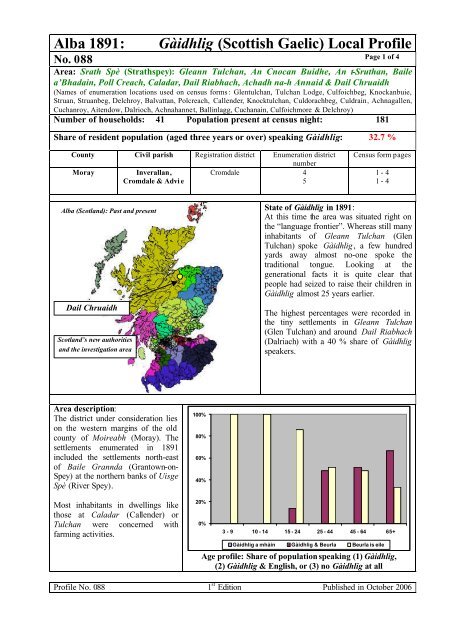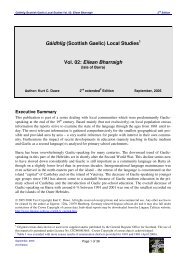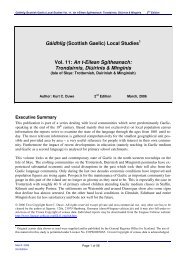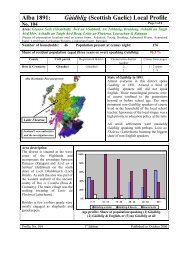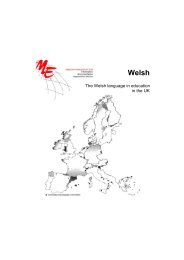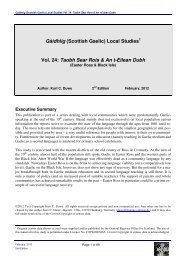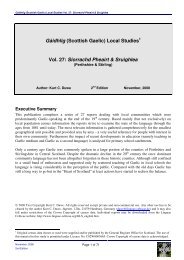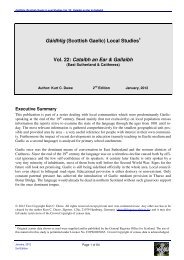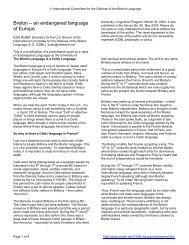Alba 1891: Gàidhlig (Scottish Gaelic) Local Profile - Linguae Celticae
Alba 1891: Gàidhlig (Scottish Gaelic) Local Profile - Linguae Celticae
Alba 1891: Gàidhlig (Scottish Gaelic) Local Profile - Linguae Celticae
You also want an ePaper? Increase the reach of your titles
YUMPU automatically turns print PDFs into web optimized ePapers that Google loves.
<strong>Alba</strong> <strong>1891</strong>:<br />
<strong>Gàidhlig</strong> (<strong>Scottish</strong> <strong>Gaelic</strong>) <strong>Local</strong> <strong>Profile</strong><br />
No. 088<br />
Page 1 of 4<br />
Area: Srath Spè (Strathspey): Gleann Tulchan, An Cnocan Buidhe, An t-Sruthan, Baile<br />
a’Bhadain, Poll Creach, Caladar, Dail Riabhach, Achadh na-h Annaid & Dail Chruaidh<br />
(Names of enumeration locations used on census forms : Glentulchan, Tulchan Lodge, Culfoichbeg, Knockanbuie,<br />
Struan, Struanbeg, Delchroy, Balvattan, Polcreach, Callender, Knocktulchan, Culdorachbeg, Culdrain, Achnagallen,<br />
Cuchanroy, Aitendow, Dalrioch, Achnahannet, Ballinlagg, Cuchanain, Culfoichmore & Delchroy)<br />
Number of households: 41 Population present at census night: 181<br />
Share of resident population (aged three years or over) speaking <strong>Gàidhlig</strong>: 32.7 %<br />
County Civil parish Registration district Enumeration district<br />
number<br />
Moray<br />
Inverallan,<br />
Cromdale 4<br />
Cromdale & Advi e<br />
5<br />
Census form pages<br />
1 - 4<br />
1 - 4<br />
<strong>Alba</strong> (Scotland): Past and present<br />
Dail Chruaidh<br />
Scotland’s new authorities<br />
and the investigation area<br />
State of <strong>Gàidhlig</strong> in <strong>1891</strong>:<br />
At this time the area was situated right on<br />
the “language frontier”. Whereas still many<br />
inhabitants of Gleann Tulchan (Glen<br />
Tulchan) spoke <strong>Gàidhlig</strong>, a few hundred<br />
yards away almost no-one spoke the<br />
traditional tongue. Looking at the<br />
generational facts it is quite clear that<br />
people had seized to raise their children in<br />
<strong>Gàidhlig</strong> almost 25 years earlier.<br />
The highest percentages were recorded in<br />
the tiny settlements in Gleann Tulchan<br />
(Glen Tulchan) and around Dail Riabhach<br />
(Dalriach) with a 40 % share of <strong>Gàidhlig</strong><br />
speakers.<br />
Area description:<br />
The district under consideration lies<br />
on the western margins of the old<br />
county of Moireabh (Moray). The<br />
settlements enumerated in <strong>1891</strong><br />
included the settlements north-east<br />
of Baile Grannda (Grantown-on-<br />
Spey) at the northern banks of Uisge<br />
Spè (River Spey).<br />
Most inhabitants in dwellings like<br />
those at Caladar (Callender) or<br />
Tulchan were concerned with<br />
farming activities.<br />
100%<br />
80%<br />
60%<br />
40%<br />
20%<br />
0%<br />
3 - 9 10 - 14 15 - 24 25 - 44 45 - 64 65+<br />
<strong>Gàidhlig</strong> a mhàin <strong>Gàidhlig</strong> & Beurla Beurla is eile<br />
Age profile: Share of population speaking (1) <strong>Gàidhlig</strong>,<br />
(2) <strong>Gàidhlig</strong> & English, or (3) no <strong>Gàidhlig</strong> at all<br />
<strong>Profile</strong> No. 088 1 st Edition Published in October 2006
<strong>Alba</strong> <strong>1891</strong>:<br />
<strong>Gàidhlig</strong> (<strong>Scottish</strong> <strong>Gaelic</strong>) <strong>Local</strong> <strong>Profile</strong><br />
No. 088<br />
Page 2 of 4<br />
Area: Srath Spè (Strathspey): Gleann Tulchan, An Cnocan Buidhe, An t-Sruthan, Baile<br />
a’Bhadain, Poll Creach, Caladar, Dail Riabhach, Achadh na-h Annaid & Dail Chruaidh<br />
Age<br />
Population enumerated Usually resident population (3+)<br />
Total Aged<br />
0-2<br />
Deaf<br />
&<br />
dumb<br />
Visitors<br />
etc. 3<br />
Total 4 <strong>Gàidhlig</strong> <strong>Gàidhlig</strong><br />
&<br />
English<br />
<strong>Gàidhlig</strong><br />
speakers<br />
(%)<br />
Total 181 5 1 7 168 0 55 32.7 %<br />
3-4 9 0 0 9 0 0 0.0 %<br />
5-9 15 0 0 15 0 0 0.0 %<br />
10-14 18 0 1 17 0 0 0.0 %<br />
15-24 36 0 0 36 0 5 13.9 %<br />
25-44 33 1 1 31 0 16 48.4 %<br />
45-64 36 0 3 33 0 17 51.5 %<br />
65+ 29 0 2 27 0 18 66.7 %<br />
Gender<br />
Female 86 2 1 3 80 0 25 32.5 %<br />
Male 95 3 0 4 88 0 29 33.0 %<br />
Place of birth<br />
Born in parish 109 5 1 2 101 0 29 28.7 %<br />
In neighbouring parish 1 21 0 0 1 20 0 8 40.0 %<br />
Gaidhealtachd elsewhere 2 23 0 0 1 22 0 15 68.2 %<br />
Other places 28 0 0 3 25 0 3 12.0 %<br />
Notes:<br />
1<br />
Parishes of Knockando, Dyke, Edinkillie (all<br />
Moray); Ardclach (Nairn), Kirkmichael (Banff);<br />
Abernethy & Kincardine, Alvie (all Inverness).<br />
2<br />
Other parishes in Scotland with more than 50 %<br />
<strong>Gàidhlig</strong> speakers in the <strong>1891</strong> census.<br />
3<br />
People described as visitors, boarders, lodgers or<br />
other similar terms.<br />
4<br />
Number of enumerated persons who were (1)<br />
older than 2 years of age, who were (2) not deaf<br />
& dumb and who (3) did not live only temporarily<br />
in the area.<br />
<strong>Gàidhlig</strong> a mhàin<br />
<strong>Gàidhlig</strong> & Beurla<br />
Beurla is eile<br />
Share of population speaking (1) <strong>Gàidhlig</strong>,<br />
(2) <strong>Gàidhlig</strong> & English, or (3) no <strong>Gàidhlig</strong> at all<br />
Background of <strong>Gàidhlig</strong> (<strong>Scottish</strong> <strong>Gaelic</strong>) <strong>Local</strong> <strong>Profile</strong>s:<br />
The <strong>1891</strong> census was the first such enumeration exercise with an unequivocal language question. After<br />
more than 100 years the original census forms are publicly available for detailed analysis. During research<br />
concerned with the “<strong>Gàidhlig</strong> (<strong>Scottish</strong> <strong>Gaelic</strong>) <strong>Local</strong> Studies” a vast number of such local statistics have<br />
been gathered about the <strong>Gàidhlig</strong> speaking population of Scotland in that year. As many of these results<br />
could not be included in the reports these concise fact-sheets are a welcome way to publish some of the<br />
“local gems”. More information is provided at http://www.linguae-celticae.org/GLP_english.htm.
<strong>Alba</strong> <strong>1891</strong>:<br />
<strong>Gàidhlig</strong> (<strong>Scottish</strong> <strong>Gaelic</strong>) <strong>Local</strong> <strong>Profile</strong><br />
No. 088<br />
Page 3 of 4<br />
Area: Srath Spè (Strathspey): Gleann Tulchan, An Cnocan Buidhe, An t-Sruthan, Baile<br />
a’Bhadain, Poll Creach, Caladar, Dail Riabhach, Achadh na-h Annaid & Dail Chruaidh<br />
Households<br />
Usually resident population (3+)<br />
Total <strong>Gàidhlig</strong> <strong>Gàidhlig</strong> &<br />
English<br />
<strong>Gàidhlig</strong><br />
speakers<br />
(%)<br />
Gleann Tulchan & Dail Chruaidh 41 168 0 55 32.7 %<br />
Individual communities<br />
Tulchan & An t-Suthan Mòr<br />
(Tulchan & Struanmore)<br />
Dail Chruaidh & Caladar<br />
(Delchroy & Callender)<br />
Achadh nan Gallan & Dail Riabhach<br />
(Auchnagallen & Dalriach)<br />
Achadh na h-Annaid<br />
(Auchnahannet)<br />
Cùl Fothaich<br />
(Culfoich)<br />
12 46 0 19 40.4 %<br />
12 41 0 11 26.8 %<br />
8 35 0 14 40.0 %<br />
6 27 0 10 37.0 %<br />
3 18 0 1 5.6 %<br />
Language of parents<br />
Both parents <strong>Gàidhlig</strong> speaking 2 7 0 5 71.4 %<br />
Single parent <strong>Gàidhlig</strong> speaking 3 18 0 3 16.7 %<br />
One parent <strong>Gàidhlig</strong> speaking 6 31 0 7 22.6 %<br />
No <strong>Gàidhlig</strong> speaking parent 6 33 0 2 6.1 %<br />
Households with no children (0-14) 24 79 0 38 48.1 %<br />
Occupation of head of household<br />
Crofter, farmer, fisherman, etc. 21 106 0 39 36.8 %<br />
Shepherd, gamekeeper or similar 4 16 0 5 33.3 %<br />
Clergyman, teacher, physician, etc. 1 2 0 0 0.0 %<br />
Mason, carpenter, merchant, etc. 3 12 0 1 8.3 %<br />
Living on private means 0 0 0 0 -<br />
Manager, coachman, cook, etc. 1 7 0 1 14.3 %<br />
Worker, farm/domestic servant, etc. 10 23 0 7 30.4 %<br />
Remaining occupations 1 3 0 2 66.7 %<br />
© Text and statistics: Copyright Kurt C. Duwe. All rights reserved except private and non-commercial<br />
use. Any other use has to be cleared by the author Kurt C. Duwe, Jägerstr. 120a, 21079 Hamburg,<br />
Germany (duwe@linguae-celticae.de) and it may also fall under restrictions of the Crown Copyright of<br />
census data. Statistics have been derived from <strong>1891</strong> census returns published by the General Register<br />
Office for Scotland (GROS). The use of this material here is permitted under Licence No. C02W0003665.<br />
Crown Copyright of census data is acknowledged. The digital boundaries shown on the Scotland map are<br />
courtesy of Ordnance Survey as part of the Geography Products provided by GROS.<br />
Additional individual profiles may be downloaded from a special page on the <strong>Linguae</strong> <strong>Celticae</strong> website:<br />
http://www.linguae-celticae.org/GLP_english.htm
<strong>Alba</strong> <strong>1891</strong>:<br />
<strong>Gàidhlig</strong> (<strong>Scottish</strong> <strong>Gaelic</strong>) <strong>Local</strong> <strong>Profile</strong><br />
No. 088<br />
Page 4 of 4<br />
Area: Srath Spè (Strathspey): Gleann Tulchan, An Cnocan Buidhe, An t-Sruthan, Baile<br />
a’Bhadain, Poll Creach, Caladar, Dail Riabhach, Achadh na-h Annaid & Dail Chruaidh<br />
Place of birth and <strong>Gàidhlig</strong> speaking:<br />
<strong>Gàidhlig</strong> was spoken by almost a third of<br />
locally born residents. Most persons with<br />
birthplaces in the wider Gaidhealtachd were<br />
<strong>Gàidhlig</strong> speakers. The vast majority of those<br />
born outside the Gaidhealtachd did not speak<br />
<strong>Gàidhlig</strong> at all.<br />
Notes:<br />
1<br />
Born either in Edinkillie or Cromdale, Inverallan<br />
& Advie (both Moray) or in the adjacent parishes<br />
of Knockando, Dyke (both Moray); Ardclach<br />
(Nairn), Kirkmichael (Banff); Abernethy &<br />
Kincardine, Alvie (all Inverness).<br />
2<br />
Born in other parishes of Scotland with more<br />
than 50 % <strong>Gàidhlig</strong> speakers in the <strong>1891</strong> census.<br />
100%<br />
80%<br />
60%<br />
40%<br />
20%<br />
0%<br />
Nearby Gaidhealtachd Elsewhere<br />
<strong>Gàidhlig</strong> a mhàin <strong>Gàidhlig</strong> & Beurla Beurla is eile<br />
Speakers according to place of birth (1) nearby 1<br />
(2) in remaining Gaidhealtachd 2 , or (3) elsewhere<br />
Remarks:<br />
1. There were no monolingual <strong>Gàidhlig</strong> speakers registered in the area in <strong>1891</strong>.<br />
2. In original census report terms the district had a population of 181 persons of all ages. 57<br />
enumerated inhabitants spoke “<strong>Gaelic</strong> and English” leading to an “official” share of<br />
<strong>Gàidhlig</strong> speakers of 31.5 %. This was only a very small under-estimate of 1.2 % compared<br />
with the realistic figures taking into account only the usually resident population.<br />
<strong>Profile</strong> No. 088 1 st Edition Published in October 2006


